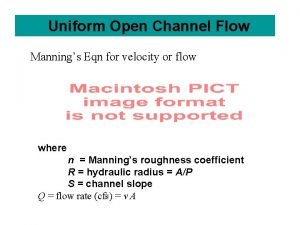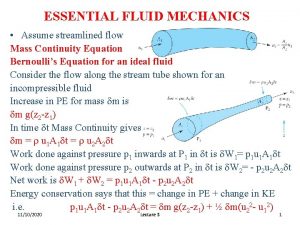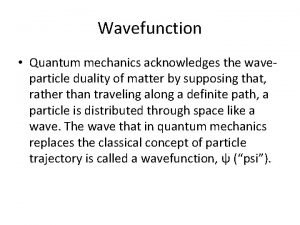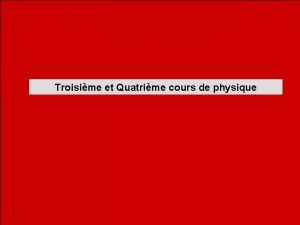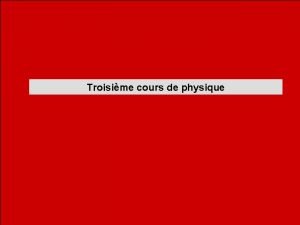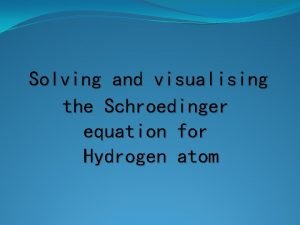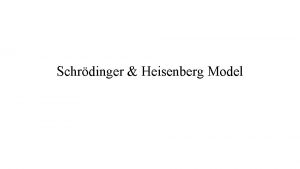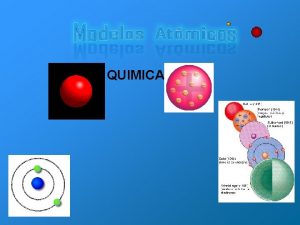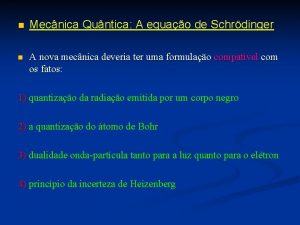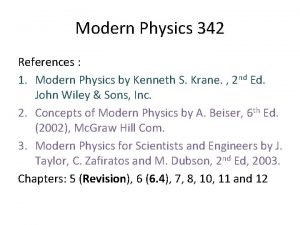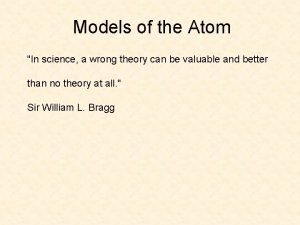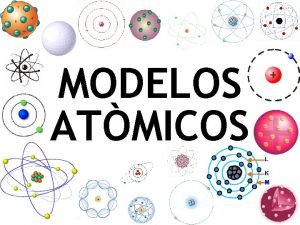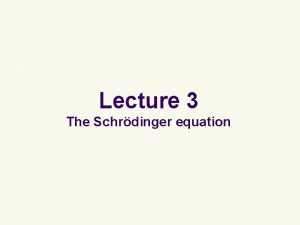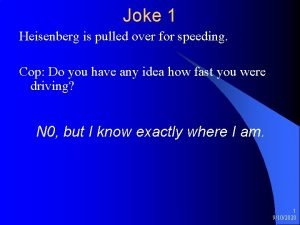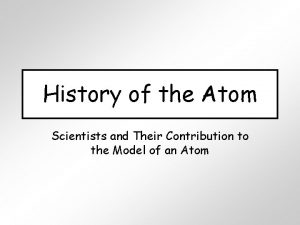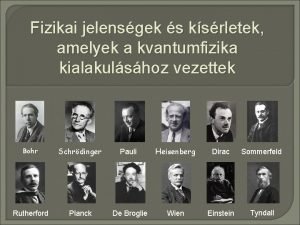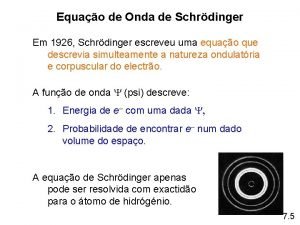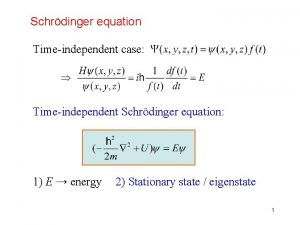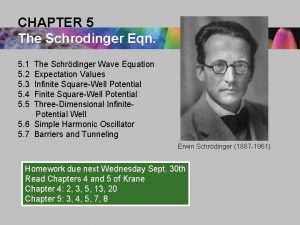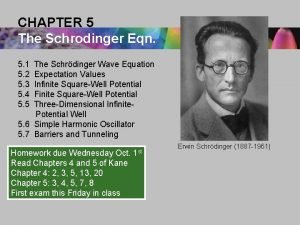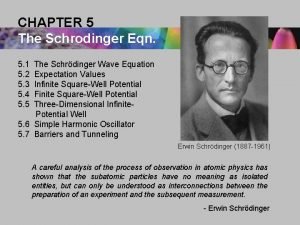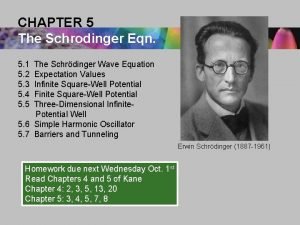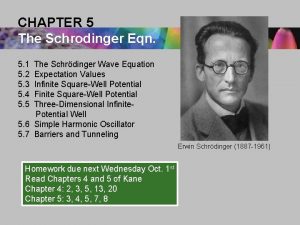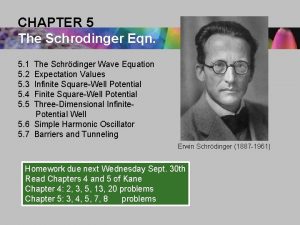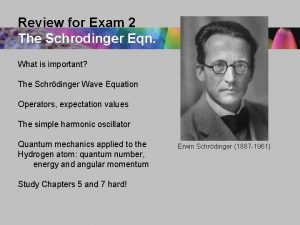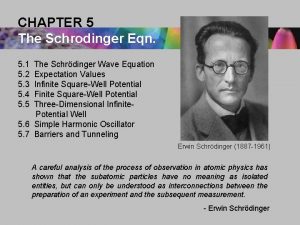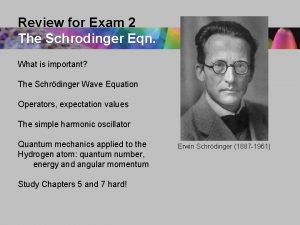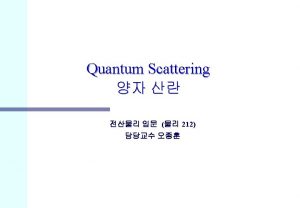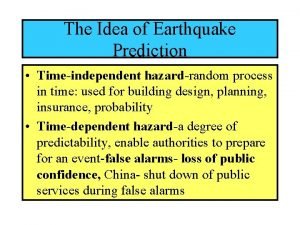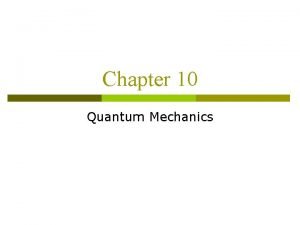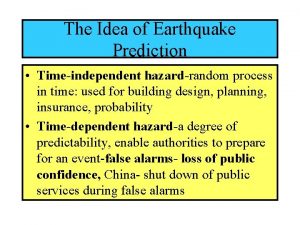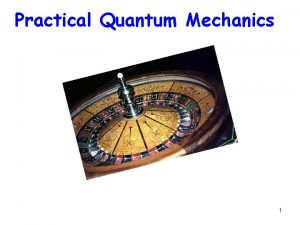Timeindependent Schrodinger eqn QM Ch 2 Physical Systems




















- Slides: 20

Time-independent Schrodinger eqn QM Ch. 2, Physical Systems, 12. Jan. 2003 EJZ Assume the potential V(x) does not change in time. Use * separation of variables and * boundary conditions to solve for y. Once you know y, you can find any expectation value!

Outline: • • “Derive” Schroedinger Eqn (SE) Stationary states ML 1 by Don and Jason R, Problem #2. 2 Infinite square well Harmonic oscillator, Problem #2. 13 ML 2 by Jason Wall and Andy, Problem #2. 14 Free particle and finite square well Summary

Schroedinger Equation

Stationary States - introduction If evolving wavefunction Y(x, t) = y(x) f(t) can be separated, then the time-dependent term satisfies (ML 1 will show - class solve for f) Separable solutions are stationary states. . .

Separable solutions: (1) are stationary states, because * probability density is independent of time [2. 7] * therefore, expectation values do not change (2) have definite total energy, since the Hamiltonian is sharply localized: [2. 13] (3) yi = eigenfunctions corresponding to each allowed energy eigenvalue Ei. General solution to SE is [2. 14]

ML 1: Stationary states are separable Guess that SE has separable solutions Y(x, t) = y(x) f(t) sub into SE=Schrodinger Eqn Divide by yf: LHS(t) = RHS(x) = constant=E. Now solve each side: You already found solution to LHS: f(t)=_____ RHS solution depends on the form of the potential V(x).

ML 1: Problem 2. 2, p. 24

Now solve for y(x) for various V(x) Strategy: * draw a diagram * write down boundary conditions (BC) * think about what form of y(x) will fit the potential * find the wavenumbers kn=2 p/l * find the allowed energies En * sub k into y(x) and normalize to find the amplitude A * Now you know everything about a QM system in this potential, and you can calculate for any expectation value

Square well: V(0<x<a) = 0, V= outside What is probability of finding particle outside? Inside: SE becomes * Solve this simple diffeq, using E=p 2/2 m, * y(x) =A sin kx + B cos kx: apply BC to find A and B * Draw wavefunctions, find wavenumbers: kn a= np * find the allowed energies: * sub k into y(x) and normalize: * Finally, the wavefunction is

Square well: homework 2. 4: Repeat the process above, but center the infinite square well of width a about the point x=0. Preview: discuss similarities and differences

Ex: Harmonic oscillator: V(x) =1/2 kx 2 • Tipler’s approach: Verify that y 0=A 0 e-ax^2 is a solution • Analytic approach (2. 3. 2): rewrite SE diffeq and solve • Algebraic method (2. 3. 1): ladder operators

HO: Tipler’s approach: Verify solution to SE:

HO: Tipler’s approach. .

HO analytically: solve the diffeq directly Rewrite SE using * At large x~x, has solutions * Guess series solution h(x) * Consider normalization and BC to find that hn=an Hn(x) where Hn(x) are Hermite polynomials * The ground state solution y 0 is the same as Tipler’s * Higher states can be constructed with ladder operators

HO algebraically: use a± to get yn Ladder operators a± generate higher-energy wavefunctions from the ground state y 0. Work through Section 2. 3. 1 together Result: Practice on Problem 2. 13

Harmonic oscillator: Prob. 2. 13 Worksheet

ML 2: HO, Prob. 2. 14 Worksheet

Ex: Free particle: V=0 • • Looks easy, but we need Fourier series If it has a definite energy, it isn’t normalizable! No stationary states for free particles Wave function’s vg = 2 vp, consistent with classical particle: check this.

Finite square well: V=0 outside, -V 0 inside • BC: y NOT zero at edges, so wavefunction can spill out of potential • Wide deep well has many, but finite, states • Shallow, narrow well has at least one bound state

Summary: • Time-independent Schrodinger equation has stationary states y(x) • k, y(x), and E depend on V(x) (shape & BC) • wavefunctions oscillate as eiwt • wavefunctions can spill out of potential wells and tunnel through barriers
 Velocity eqn
Velocity eqn Kutta–joukowski theorem
Kutta–joukowski theorem Embedded systems vs cyber physical systems
Embedded systems vs cyber physical systems Expectation value of hermitian operator
Expectation value of hermitian operator Equation de schrodinger
Equation de schrodinger Equation de schrodinger
Equation de schrodinger Solving schrodinger equation for hydrogen atom
Solving schrodinger equation for hydrogen atom Persamaan schrodinger
Persamaan schrodinger S bohr model
S bohr model Mg modelo de dalton
Mg modelo de dalton Equação de schrodinger
Equação de schrodinger Schrodinger hypothesis
Schrodinger hypothesis Quantum mechanical atomic model
Quantum mechanical atomic model Modelo atomico modelo actual
Modelo atomico modelo actual Schrodinger time dependent equation
Schrodinger time dependent equation Jokes
Jokes Erwin schrödinger contribution to atomic theory
Erwin schrödinger contribution to atomic theory Aplikasi persamaan schrodinger
Aplikasi persamaan schrodinger Schrödinger macskája érthetően
Schrödinger macskája érthetően Contoh soal fungsi eigen
Contoh soal fungsi eigen Equações químicas
Equações químicas
